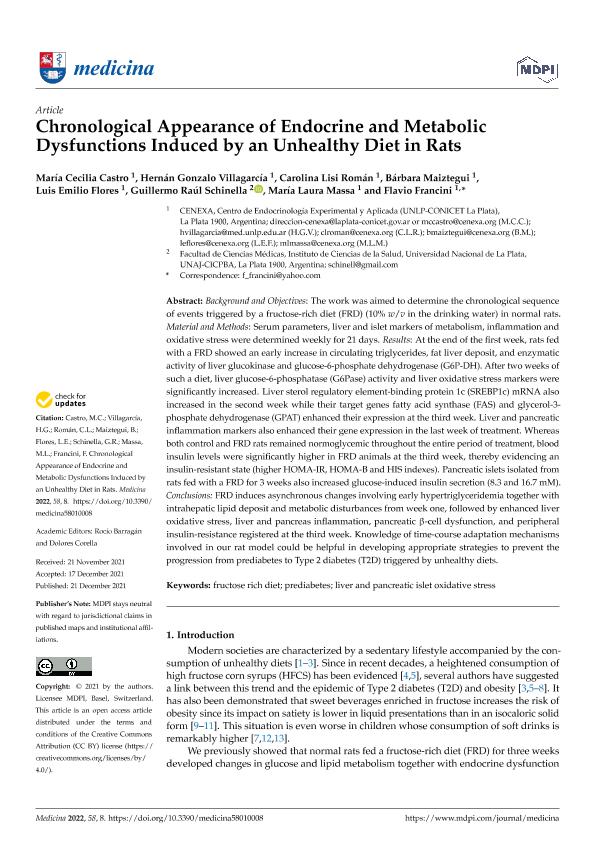Artículo
Chronological appearance of endocrine and metabolic dysfunctions induced by an unhealthy diet in rats
Castro, María Cecilia ; Villagarcía, Hernán Gonzalo
; Villagarcía, Hernán Gonzalo ; Román, Carolina Lisi
; Román, Carolina Lisi ; Maiztegui, Barbara
; Maiztegui, Barbara ; Flores, Luis Emilio
; Flores, Luis Emilio ; Schinella, Guillermo Raúl; Massa, Maria Laura
; Schinella, Guillermo Raúl; Massa, Maria Laura ; Francini, Flavio
; Francini, Flavio
 ; Villagarcía, Hernán Gonzalo
; Villagarcía, Hernán Gonzalo ; Román, Carolina Lisi
; Román, Carolina Lisi ; Maiztegui, Barbara
; Maiztegui, Barbara ; Flores, Luis Emilio
; Flores, Luis Emilio ; Schinella, Guillermo Raúl; Massa, Maria Laura
; Schinella, Guillermo Raúl; Massa, Maria Laura ; Francini, Flavio
; Francini, Flavio
Fecha de publicación:
05/2021
Editorial:
Multidisciplinary Digital Publishing Institute
Revista:
Medicina
ISSN:
0076-6046
e-ISSN:
1648-9144
Idioma:
Inglés
Tipo de recurso:
Artículo publicado
Clasificación temática:
Resumen
Background and Objectives: The work was aimed to determine the chronological sequence of events triggered by a fructose-rich diet (FRD) (10% w/v in the drinking water) in normal rats. Material and Methods: Serum parameters, liver and islet markers of metabolism, inflammation and oxidative stress were determined weekly for 21 days. Results: At the end of the first week, rats fed with a FRD showed an early increase in circulating triglycerides, fat liver deposit, and enzymatic activity of liver glucokinase and glucose-6-phosphate dehydrogenase (G6P-DH). After two weeks of such a diet, liver glucose-6-phosphatase (G6Pase) activity and liver oxidative stress markers were significantly increased. Liver sterol regulatory element-binding protein 1c (SREBP1c) mRNA also increased in the second week while their target genes fatty acid synthase (FAS) and glycerol-3-phosphate dehydrogenase (GPAT) enhanced their expression at the third week. Liver and pancreatic inflammation markers also enhanced their gene expression in the last week of treatment. Whereas both control and FRD rats remained normoglycemic throughout the entire period of treatment, blood insulin levels were significantly higher in FRD animals at the third week, thereby evidencing an insulin-resistant state (higher HOMA-IR, HOMA-B and HIS indexes). Pancreatic islets isolated from rats fed with a FRD for 3 weeks also increased glucose-induced insulin secretion (8.3 and 16.7 mM). Conclusions: FRD induces asynchronous changes involving early hypertriglyceridemia together with intrahepatic lipid deposit and metabolic disturbances from week one, followed by enhanced liver oxidative stress, liver and pancreas inflammation, pancreatic β-cell dysfunction, and peripheral insulin-resistance registered at the third week. Knowledge of time-course adaptation mechanisms involved in our rat model could be helpful in developing appropriate strategies to prevent the progression from prediabetes to Type 2 diabetes (T2D) triggered by unhealthy diets.
Archivos asociados
Licencia
Identificadores
Colecciones
Articulos(CENEXA)
Articulos de CENTRO DE ENDOCRINOLOGIA EXP.Y APLICADA (I)
Articulos de CENTRO DE ENDOCRINOLOGIA EXP.Y APLICADA (I)
Citación
Castro, María Cecilia; Villagarcía, Hernán Gonzalo; Román, Carolina Lisi; Maiztegui, Barbara; Flores, Luis Emilio; et al.; Chronological appearance of endocrine and metabolic dysfunctions induced by an unhealthy diet in rats; Multidisciplinary Digital Publishing Institute; Medicina; 58; 1; 5-2021; 1-13
Compartir
Altmétricas



